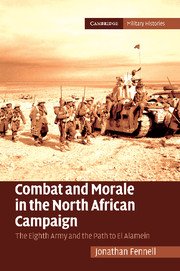Book contents
- Frontmatter
- Contents
- List of illustrations
- List of figures
- List of maps
- List of tables
- Acknowledgements
- List of abbreviations
- Maps
- Introduction
- 1 Morale crisis and recovery
- 2 Technology, firepower and morale
- 3 Quality of manpower and morale
- 4 Environment, provisions and morale
- 5 Welfare, education and morale
- 6 Leadership, command and morale
- 7 Training and morale
- 8 In search of a theory to explain combat morale in the desert
- Conclusion
- Appendix: Battle maps
- Bibliography
- Index
- References
6 - Leadership, command and morale
Published online by Cambridge University Press: 24 February 2011
- Frontmatter
- Contents
- List of illustrations
- List of figures
- List of maps
- List of tables
- Acknowledgements
- List of abbreviations
- Maps
- Introduction
- 1 Morale crisis and recovery
- 2 Technology, firepower and morale
- 3 Quality of manpower and morale
- 4 Environment, provisions and morale
- 5 Welfare, education and morale
- 6 Leadership, command and morale
- 7 Training and morale
- 8 In search of a theory to explain combat morale in the desert
- Conclusion
- Appendix: Battle maps
- Bibliography
- Index
- References
Summary
The most important thing about a commander is his effect on morale.
(Field Marshal William Slim)My theory is that an army commander does what is necessary to accomplish his mission and that nearly 80 percent of his mission is to arouse morale in his men.
(General George Patton)The art of leading, in operations large or small, is the art of dealing with humanity.
(S. L. A. Marshall)Since the publication of Correlli Barnett's The Desert Generals, a debate has raged on who should take the credit for Eighth Army's victories at Alam Halfa and El Alamein. This debate has highlighted both the excesses of Bernard Montgomery's character and the important contribution of Claude Auchinleck to victory in the desert. It has also played a vital role in bringing balance to the historiography of the desert war. However, the dialectical Montgomery versus Auchinleck approach that has developed has distracted historians from some of the key factors that led to victory in North Africa. In particular, it has pushed the issue of morale to the sidelines of the search for explanations of victory and defeat in the desert.
The reality of a morale crisis in the summer of 1942 clearly brings into question the contribution and performance of Auchinleck as Commander-in-Chief MEF. It is hardly surprising, therefore, that supporters of Auchinleck, such as Barnett, have queried the existence of such a crisis and argued that ‘it would be wrong to place too much emphasis on the moral effects produced by [Montgomery]: for in the words of the Official History, Auchinleck “had retained to a remarkable degree [his army's] admiration and confidence”’.
- Type
- Chapter
- Information
- Combat and Morale in the North African CampaignThe Eighth Army and the Path to El Alamein, pp. 188 - 218Publisher: Cambridge University PressPrint publication year: 2011

